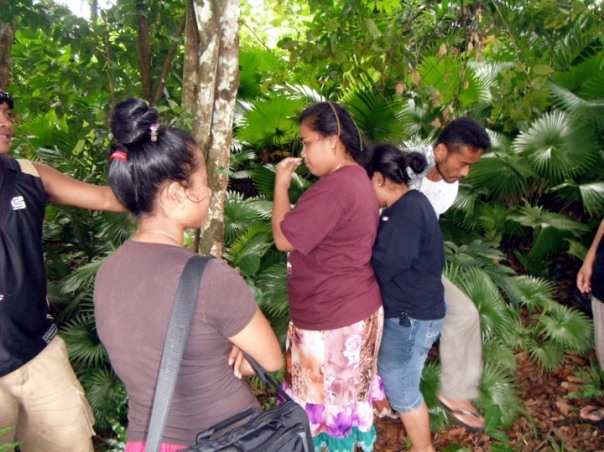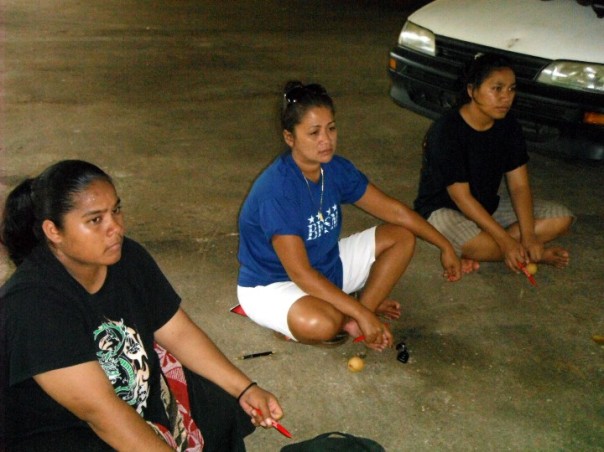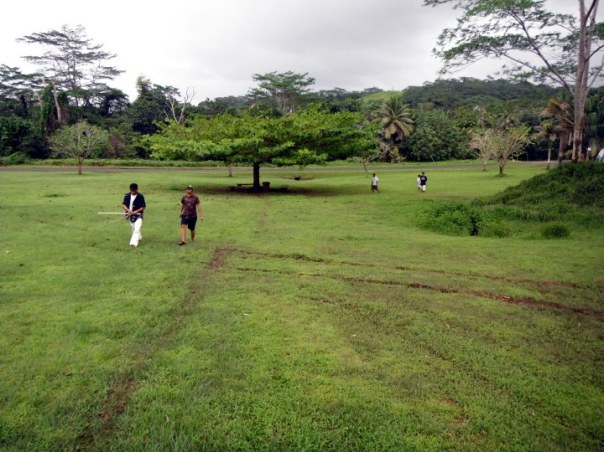The week of 19 December marked the start of the Teacher Corps winter workshop with a focus on mathematics and sciences.
The workshop opened at 08:00 with a focus on the FSM national standards and benchmarks in science calling for the use of simple measuring tools (Sci 1.3.3, 1.6.4). Meter sticks were constructed from locally available wood (Hibiscus tiliaceus, Campnosperma brevipetiolata) in order to measure lengths.
Rulers were used for measures less than one meter.
Mass was measured by suspending the meter sticks from the 50 centimeter mark, suspending a known locally available mass from one arm, and suspending an unknown mass from the other arm. For a known mass the class used bars of hand soap which were labeled as having a mass of 113 grams.

The farther out along the arm the masses can be suspended, the more accurate the mass measurement. As per physical science laboratory one, the volume of the unknown mass was determined by carving the soap into a rectangular slab and then using length times width times height to obtain the volume.
This yielded a density of less than one gram per cubic centimeter for Ivory® soap, more than one gram per cubic centimeter for the other soaps in the laboratory. This leads to a prediction on whether a given brand of soap will float, a prediction which can be tested.
The Ivory has to be measured as carefully as possible as the density is just under one gram per cubic centimeter.
Density is a physical property, which is a focus of FSM science standards 2.3.1, 2.5,2, and 2.6.3. Note that the first digit refers to the standard, the second digit refers to the grade, and the last digit is the outcome. The standards are:
- Number, completeness, and computation
- Geometry, measurement, and transformation
- Patterns and algebra
- Statistics and probability
At 10:00 the focus shifted from science to the precursors of mathematics. The teachers were introduced to the basics of set theory in order to prepare them for Al’Mat and Al’Jabr the next day.
Set theory and the presentations that would follow provide examples math standard 1.3.4, representing whole numbers using physical models and diagrams, and the extension of those models into arithmetic and algebra.
After a lunch break the teachers were tasked with counting the pillars and posts on campus – at least all of the pillars and posts for the buildings and walkways connected by covered walkways.
The four groups of teachers returned with the numbers 250, 267, 286, and 364. The object was to demonstrate the inherent “fuzziness” of even a simple measurement. The teachers all averred that there is a correct number of pillars, but they were unable to agree on the actual value.
The exercise also brought to the fore the need to specify definitions prior to gathering data.
The lack of a single value led naturally to a discussion of the role of range, mode, median, and mean as ways of characterizing a data set. While the college posts and pillars are a handy, countable item, the teachers will have to select other locally available numerous items to count if they choose to replicate this activity. The activity was based loosely on an activity I did with the Upward Bound students in the summer of 2007.
The statistics unit address math standards 4.4.1 collect data, 4.5.2 organize data using tables, charts, 4.6.1 range, mode, median mean, and 4.8.1 choosing the best measure of middle.
The planned end of day hike was rained-out and evening was settling in, hence the workshop dismissed for the day.
Tuesday morning the teachers measured the speed of sound using nothing more than their homemade meter sticks, counting the seconds orally, and two blocks of wood. The exercise was a modification of physical science laboratory nine.

Above the teachers are laying their meter sticks end-to-end to measure the distance for the echo flight.

Bear in mind that the meter sticks were constructed by first using a commercial meter stick to determine a distance on the teacher’s own body that is one meter. This was then their standard for building their own meter sticks. If nothing else, one has one’s body as a starting place to make new meter sticks in the future.

The total distance from the building to the road was 80 meters. The sound echoes produced traveled double that distance, 160 meters. While one teacher counted “one-one thousand, two-one thousand, three-one thousand,…” up to ten seconds, a second teacher clapped two boards in synch with the echoes. A third teacher counted the claps.

On one of the trials the teachers counted 23 claps of the wooden boards – 23 echo flights – in ten seconds. That means a flight time of 0.43 seconds per echo. Dividing 160 meters by the flight time yields an estimated speed of sound of 368 meters per second.
At the air temperature on Pohnpei, sound travels at 350 meters per second, give or take two meters per second. This means that using only sticks from the forest, oral time counts, and two boards, the teachers obtained a result accurate to within 5%.
The speed of sound unit served science 1.3.3, 1.6.4, 2.6.3, and a blend of 2.8.3 describe sound coupled with 2.8.4 kinds of motion.
With the weather looking good, the teachers slipped in a hike down the road to look at ferns including Davallia pectinata (syn Humata banksii). The fern is presently identified as being either limwediliniak or kelmahu. The fern is not one the students had ever noticed before – at a glance one might think the fern is Dicranopteris linearis (mwedil en mal), but the “pectoral” fins on the D. pectinata are distinctive. In addition, D. linearis is terrestrial, D. pectinata is epiphytic. Other plants were also covered on this walk, with support material available in the ethnobotany text. This unit serves science outcome 4.3.4, identifying common plants around the school.
Just after 10:00 on Tuesday the class moved on into Al Mat, the mathematics of marbles. This unit sought to make concrete concepts such as identity, closure, commutivity, and distribution. This section served math standards 1.3.3 understanding arithmetic operations, 1.3.4 and 1.4.3 represent whole numbers using physical models and diagrams, as well as 3.6.2 represent patterns pictorially. The unit included a brief introduction to Al Jabr, although this topic would be further developed on Wednesday.
The teachers broke for lunch. Lunch was followed by a fifty minute high-speed introduction to botanic diversitry, charging from mosses through seedless vascular plants, up through gymnosperms and on into angiosperms. The teachers were also introduced to the college herbarium and the information contained therein. This and the following field trip served science outcome 4.5.2, distinguishing plants with and without seeds.
This was followed by a field trip that hit three broad areas in a single two hour session. The teachers toured the Pwunso botanic garden and were shown economically important plants such as clove trees, cinnamon trees, coffee, black pepper, nutmeg, allspice, mahogany, kauri pine, cook island pine (timber tree), and teak.

Note that the cinnamon trees might easily be mistaken for madeu, the trees are, however, Cinnamomum verum, not Cinnamomum carolinense.

The teachers were also specifically introduced to the gymnosperms present at Pwunso including Cook island pines, a large cycad, and the kauri pines.

The third leg of the field trip was a presentation by Emihner Johnson of the Island Food Community of Pohnpei on the CHEEF (Culture, health, environmental, economic, food security) benefits of local food.

Wednesday morning the teachers engaged in a laboratory designed to serve mathematics outcomes 3.7.3 locate points on the coordinate plane and 3.8.2 graph linear functions in two variables using a table of coordiante pairs. This exercise was based on physical science laboratory two.
While the physical science laboratory utilizes a ramp to produce reproducible speeds, the activity Wednesday morning was done on the front porch of the A building using a bowled four square ball. Like the physical science laboratory, the data was plotted loosely on poster pad, but with a twist.

In the first phase time was counted orally (x axis variable), but distance was denoted using only the names of the teachers. The teachers stood at the “second” mark as per physical science laboratory two, but the y-axis was initially just their names spaced roughly as they had been spaced on the front porch.

The teachers were then introduced to “marbles in equals marbles out” and “speed in equals speed out” based on physical science laboratory four. The teachers at first proposed that “force” or “energy” accounted for the behavior of the marbles, but when pressed none could use their term in an explanatory fashion.
Too often “magic words” are used to “explain” phenomenon without understanding what the magic words mean. Magic words also often paper over the deeper mystery of a system, such as how the marbles keep count. The teachers, fascinated by the marbles, spent rest of the first morning session chasing ideas about why the marbles were behaving as they did.
At 10:00 the grounds crew began cutting grass with weed wackers (string trimmers) on the south side of the building while the electrical crew began drilling concrete on the north side of the building. This provided a perfect excuse to go peripatetic, and the teachers wandered off to the front of the library for an Aristotelian peripatetic school presentation on Al Jabr, Categorical Propositions, the Square of Opposition, and Syllogisms.
Materials for Al Jabr were spread on a towel on the sidewalk. Logic was presented purely orally, in keeping with the theme. As a help to the Peripatetic pupils, handouts were also provided.
The session was too brief to properly cover such a broad range of topics. Also covered was being adaptive in one’s teaching. When the classroom became unusable, the class moved. Education can happen without a classroom, without supplies, without blackboards and chalk.
The Federated States of Micronesia and the education systems therein face an uncertain financial future at best, severe budget cuts year-on-year going forward to 2023 and beyond. Should the nation suddenly stumble into unexpected wealth, then teachers will likely have dream classrooms. At present, however, the financial outlook for the schools is bleak. Teachers will have to learn to make do with whatever they can scrounge up, cobble together, and create. One of the aims of the workshop is to begin to provide exactly those tools to the next generation of teachers.
As in the days of Aristotle walking and lecturing in the agora, the listeners became distracted by the aroma of lunch and the class broke for their midday meal. Thanks are due to the teacher corps coordinator for arranging lunch, this provides an opportunity for the workshop to socialize together over a meal, including the instructor who also chose to eat in the cafeteria.
After lunch on Wednesday we looked at CD spectra boxes, colors, spectral lines, and RGB generated images.

This unit started off serving science outcome 1.3.1 make observations, with the observation initially being the colors of the solar spectrum as seen in a CD spectroscope. In the CD spectroscope image below the lines of helium can be seen.

While helium discharge tubes are obviously not going to be available, the teachers were then instructed to point their spectroscopes at the fluorescent lights. The fluorescent lights also produced a discrete set of spectral lines. These lines were connected back to electron orbitals – a physical property of atoms – and to the development of quantum mechanics.
In the last session on Wednesday the class went on anther hike to look at more local plants including lycopodium and a variety of healing and food plants. This session continues the work on serving science outcome 4.3.4, identifying common plants around the school.


